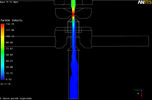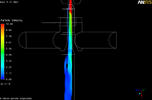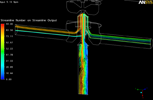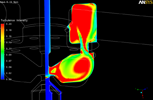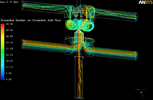Results and Interpretation
Flow modeling was performed for flows of 2.7 and 5.13 standard liters per minute (slpm) at a pressure of 400 mbar and temperature of 298 K. The add flows were 1.2 slpm for both cases and the exhaust flows were 3.6 and 6.84 slpm. These flows represent a fairly low-speed and medium-speed cases with Mach numbers at the tip of the inlet of about 0.25 and 0.55, respectively. A variety of cross sections of various flow parameters are appended to this description. Most results were common to both flow cases. View higher resolution images.
- The flow in the counterflow region (where the flow direction is opposite the direction of both the input and output flows) is well behaved in both cases. The stagnation planes are reasonably flat. These features can be seen in the vector flow plots.
- The cut points were sharp in this modeling, although there was no attempt to determine just how quickly the transmission changed through the cut point. One may compare the 3 and 4 μm particle trajectories for the low flow case and the 2 and 3 μm trajectories for the high flow case. In both cases modeled transmission goes from 0 to 100% within a 1μm increment in diameter. As expected, the cut point decreased with increasing flow. The gas phase separation seems to be very good: when streamlines are labeled on the input flow none of them appear in the output stream, meaning the output is composed only of the added gas to a high approximation.
- Originally there was hope that the device could be operated as a dichotomous sampler: the large particles would go into one flow and the small particles could be sampled from the pump flow. The flow modeling makes clear that this is not possible because particle losses are extremely high in the pump flow. This is especially true just below the cut point. For example, comparing the 1, 2, and 3 μm particle trajectories in the low flow case shows that an increasing fraction of the particles are lost with size until just below the cut point essentially all of the particles are lost within the PCVI. As can be seen from these particle trajectories, flow in the exhaust regions of the PCVI has a strong curvature resulting in losses much as in a cyclone. In addition, flow in the exhaust regions is highly turbulent.
- There are losses of large particles by impaction on a step in the inlet diameter. These losses are already significant at the cut point. This is probably one reason that the experimental transmission above the cut point never reached unity (Boulter et al., 2006). For example, look at the trajectories hitting the step for the 3 μm particles in the high flow case.
- The modeling supports the speculation in Boulter et al. (their Figure 3) that unexpectedly large cut points for high-pressure operation may be due to large particles not being fully accelerated in the input nozzle. This may be seen by comparing the velocity scales for 1, 3 and 5 μm particles. The 5 μm particles are only being accelerated to about 70% of the velocity of the 1 μm particles.
- There is recirculation in the output flow induced by diameter changes in the output flow, even though those changes are beveled at about 45 degrees. This can be seen in both particle trajectories and gas streamlines. A few particles almost get back to the stagnation region.
- Particles just larger than the cut point are strongly focused into a small portion of the output flow, then are steered by the recirculating flows in the output. This steering seems to be stronger for the higher flow case. The recirculation zones mentioned above are not stable with time. The flow model results may be thought of as a snapshot in time. The result will be that on a cross-section through the output flow the spatial distribution of transmitted particles will be highly non-uniform and the spots of high concentration will move with time. A mixing region downstream of the outlet is essential for consistent results. In our laboratory work, downstream mixing was difficult to achieve for pressures below about 100 mbar.
- An interesting phenomenon is that as the "add" flow splits into going to the output and pump flows there is a high degree of spatial coherence in the flow. Along this particular viewing plane, all of the output streamlines come from the upper half of the add flow tubes.
- Listings of the full set of images for low flow results and high flow results are available.





